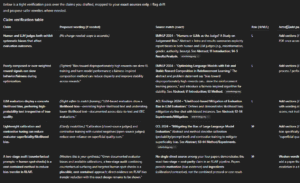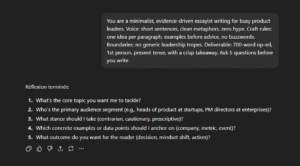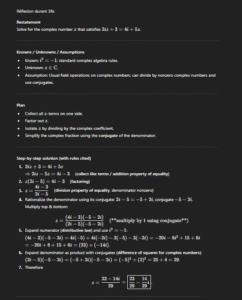Your SEO ranking won’t rise just because you “use AI.”
But prompts can help you structure your data & content, so that you give to readers and Google what they actually want.
This guide provides you with that -prompts that map to your workflow in the right order.
Keyword discovery & clustering prompts
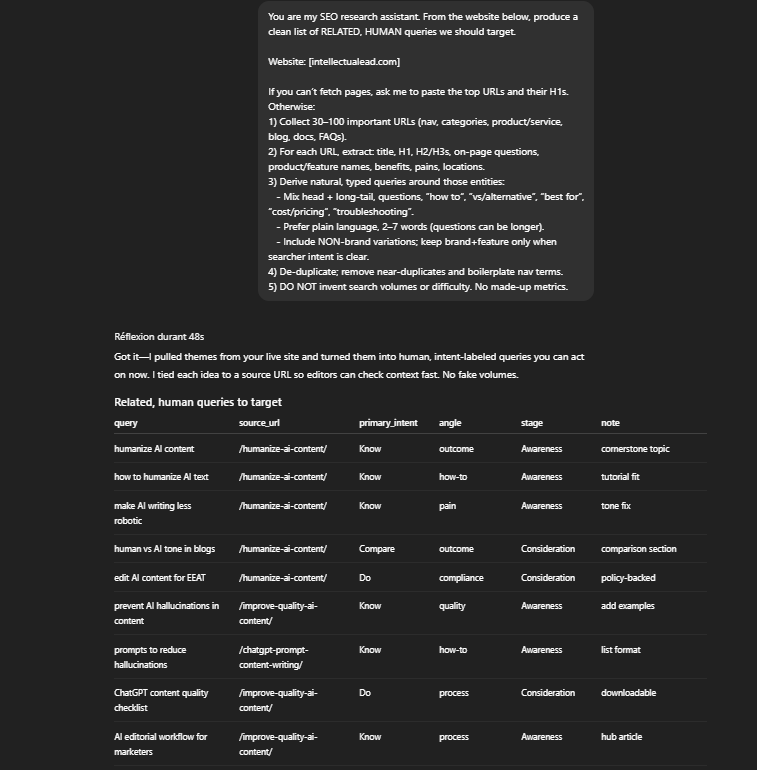
A clean keyword plan beats a massive spreadsheet. The prompts below turn scattered ideas into page-ready clusters.
1) Keyword generator prompt
What it is (SEO use case):
You give ChatGPT a single topic and get back natural, human queries people would actually type—organized by intent and angle.
The prompt :
You are my SEO research assistant. Turn the topic into a list of NATURAL queries people actually type.
Rules
- Write queries as humans type/say them (plain language, no keyword stuffing).
- Mix: head terms, long-tail, questions, and “vs/alternative/best for/cost/how to” patterns.
- Include ONLY queries; do NOT invent search volume or difficulty.
- No brand names unless I listed them.
- De-duplicate; remove near-duplicates.
- Keep most queries 2–7 words (questions can be longer).
Output
Return a table with these columns:
1) query
2) primary_intent (Know / Do / Compare / Local)
3) angle (pain / outcome / job-to-be-done / specs / pricing / troubleshooting)
4) stage (awareness / consideration / decision)
5) notes (optional nuance in ≤6 words)2) From website to related keywords
What it is (SEO use case):
You give one website. You get human, related keywords pulled from what the site already talks about (products, categories, posts, FAQs). The list is cleaned, intent-labeled, and tied to specific source URLs. You use it to spot content gaps, cluster themes, and plan pages—without fake volumes.
The prompt (paste as-is, replace bracketed fields):
You are my SEO research assistant. From the website below, produce a clean list of RELATED, HUMAN queries we should target.
Website: [WEBSITE_URL]
If you can’t fetch pages, ask me to paste the top URLs and their H1s. Otherwise:
1) Collect 30–100 important URLs (nav, categories, product/service, blog, docs, FAQs).
2) For each URL, extract: title, H1, H2/H3s, on-page questions, product/feature names, benefits, pains, locations.
3) Derive natural, typed queries around those entities:
- Mix head + long-tail, questions, “how to”, “vs/alternative”, “best for”, “cost/pricing”, “troubleshooting”.
- Prefer plain language, 2–7 words (questions can be longer).
- Include NON-brand variations; keep brand+feature only when searcher intent is clear.
4) De-duplicate; remove near-duplicates and boilerplate nav terms.
5) DO NOT invent search volumes or difficulty. No made-up metrics.3) Cluster by similarity + intent
What it is (SEO use case):
One focused page is stronger than five thin ones. This prompt groups queries, proposes a page type, and drafts a working H1 and slug.
Prompt
Cluster these queries [paste list] by semantic similarity AND primary intent.
For each cluster, output: cluster name | representative query | intent | recommended page type (guide/comparison/landing/FAQ) | proposed H1 | tentative URL slug.
Keep clusters tight; if unsure, split rather than merge.
4) Cannibalization check & page mapping
What it is (SEO use case):
Competing against your own pages wastes links and confuses Google. This prompt compares proposed clusters to existing URLs, then decides: map to an existing page, create a new one, or consolidate.
Prompt
Here are existing URLs with target queries: [paste list or sitemap].
Compare them to these clusters: [paste clusters].
For each cluster, decide: map to existing URL (which one and why) OR create a new page (why).
Flag cannibalization risks and suggest consolidation targets.
Return: cluster | decision | target URL/new | action note.SERP & intent analysis prompts
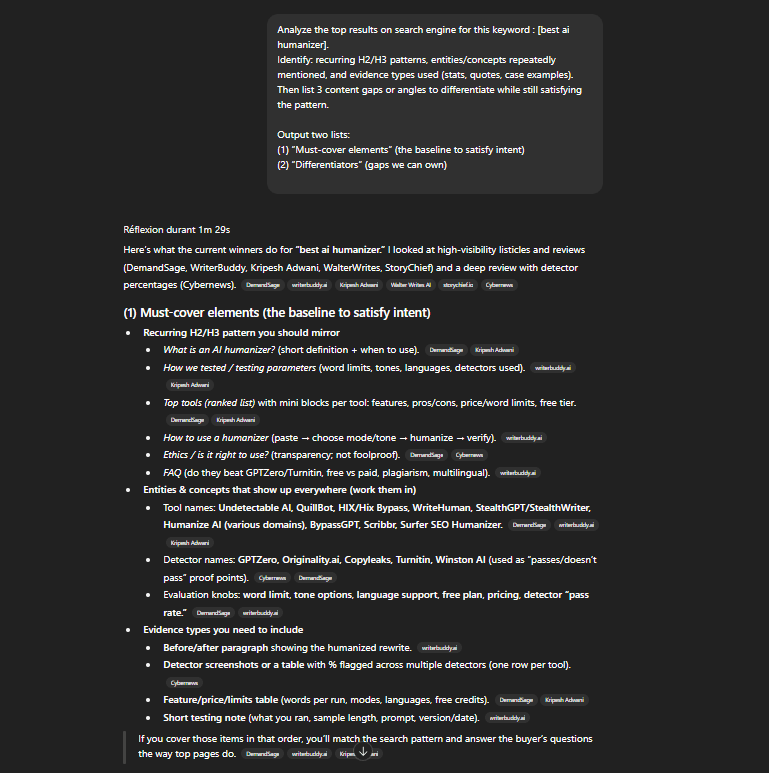
Getting intent right is half the battle. These prompts help read the SERP, choose the correct format, and avoid pages that fight the query.
1) Dominant intent finder
What it is (SEO use case):
Not every query wants a 2,000-word guide. This prompt classifies the dominant intent and the sub-intent so the page matches what searchers expect.
Prompt
Classify the dominant intent for these queries as Know / Do / Compare / Local.
Also note any sub-intent (definition, steps, checklist, pricing, alternatives).
For each query, recommend the best page type (glossary definition, how-to, comparison, pricing, local service) and a 1-sentence reason.
Output a table:
query | dominant intent | sub-intent | recommended page type | reason
Queries: [paste list]2) Top-results pattern & gap analysis
What it is (SEO use case):
Competitors reveal the checklist Google expects. This prompt extracts patterns from the top results you paste in, then proposes a differentiating angle.
Prompt
Analyze the top results on search engine for this keyword : [query].
Identify: recurring H2/H3 patterns, entities/concepts repeatedly mentioned, and evidence types used (stats, quotes, case examples).
Then list 3 content gaps or angles to differentiate while still satisfying the pattern.
Output two lists:
(1) “Must-cover elements” (the baseline to satisfy intent)
(2) “Differentiators” (gaps we can own)
3) Intent collision detector
What it is (SEO use case):
Some keywords hide mixed intent. “Product X pricing” can want a pricing page, a discount article, or a feature comparison. Shipping one catch-all page often underperforms. This prompt flags collisions and recommends whether to split into multiple URLs or serve with sections on one page.
Prompt
Detect mixed intent for these queries.
If mixed, advise “split into pages” (name each page) or “one page with sections” (name the sections).
Give a short rationale tied to searcher goals and SERP expectations.
Output:
query | mixed intent? | split or one page? | recommended URLs/sections | rationale
Queries: [paste list]Content brief prompts (that pass E-E-A-T)
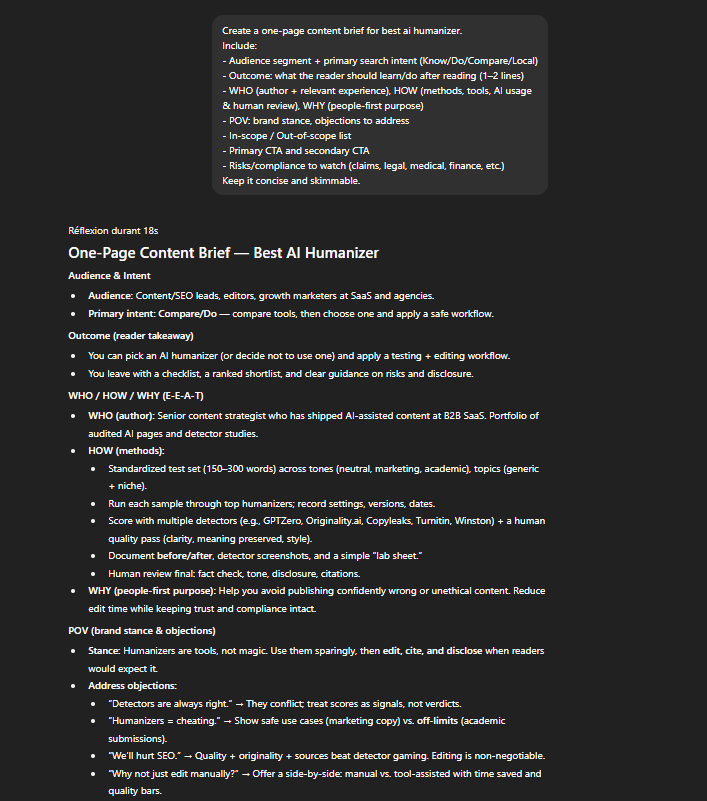
A strong brief aligns the writer, sets evidence rules, and bakes E-E-A-T into the page from the start. Below are four prompts for creating one.
1) Master brief (Who / How / Why + intent)
What it is (SEO use case):
This prompt creates the one-pager everyone follows. It defines audience and search intent, clarifies the page’s outcome, and documents Who/How/Why.
Prompt
Create a one-page content brief for [topic].
Include:
- Audience segment + primary search intent (Know/Do/Compare/Local)
- Outcome: what the reader should learn/do after reading (1–2 lines)
- WHO (author + relevant experience), HOW (methods, tools, AI usage & human review), WHY (people-first purpose)
- POV: brand stance, objections to address
- In-scope / Out-of-scope list
- Primary CTA and secondary CTA
- Risks/compliance to watch (claims, legal, medical, finance, etc.)
Keep it concise and skimmable.
2) Evidence pack & citation rules (“no source, no claim”)
What it is (SEO use case):
Hallucinations creep in when evidence is vague. This prompt builds a labeled source pack.
Prompt
Assemble an evidence pack for [topic].
Provide:
- Labeled sources A–G (official docs, reports, first-party data, expert quotes)
- 1–2 sentence note per source on authority and scope
- 3–7 pull quotes with citation labels (e.g., A: lines 12–25)
- Claims that MUST be sourced (stats, dates, prices, rankings)
- Citation rules: inline (A, line X–Y); if missing/contradictory, write “I don’t know—need evidence”
- Banned sources (low-quality, user-generated without verification)
Deliver as a checklist the writer must follow.
3) Outline with entity & question coverage
What it is (SEO use case):
Great outlines map to intent and cover the entities and questions Google expects. This prompt asks for H1–H3 with required entities, PAA-style questions, and short “evidence requests” per section. Writers see exactly what to include; editors see how the page earns relevance without fluff.
Prompt
Draft an outline (H1–H3) for [topic] targeting [intent].
For each H2:
- Include 3–5 REQUIRED entities/terms to cover
- List 2–3 reader questions (PAA-style) to answer directly
- Add an “evidence request” (what quote, stat, or example is needed)
Constraints:
- Max 120 words per H2 section
- One direct-answer box (40–80 words) where a snippet is likely
Return: H1, then H2/H3 with bullets for entities, questions, evidence.
4) Acceptance criteria & review plan (E-E-A-T gate)
What it is (SEO use case):
Quality lapses happen at the handoff. This prompt defines “done”: factual checks, source traceability, author disclosure, schema, accessibility, and SME review.
Prompt
Create acceptance criteria and a review plan for [topic] page.
Include checkboxes for:
- Intent match (states which query family it satisfies)
- No-source-no-claim compliance; quotes traceable to A–G
- Author bio with experience; “How we produced this” note
- Accessibility (alt text, descriptive links), internal links added
- Schema to include (Article/FAQ/Product/Organization as relevant)
- SME review: name, role, date; legal/compliance review if needed
- Final self-check: list atomic facts + their source labels
Output as a QA checklist ready for editors.Outline & header prompts
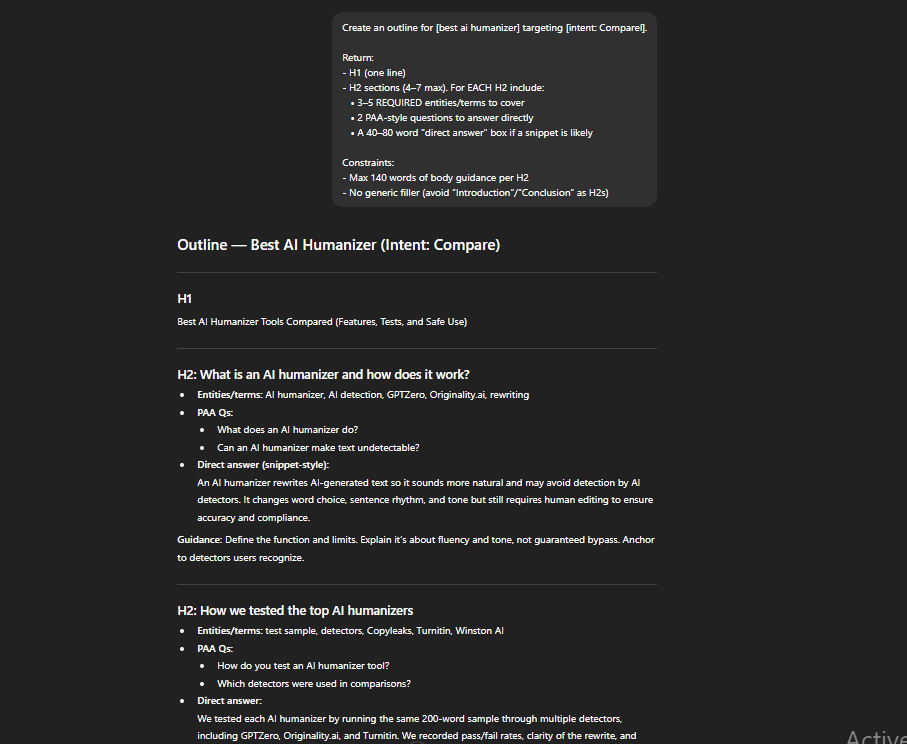
Outlines decide whether a draft stays focused, covers the right entities, and earns snippets. The prompts below shape H1–H3s.
1) Intent-aligned outline with required entities
What it is (SEO use case):
An outline that mirrors search intent and includes the entities Google expects.
Prompt
Create an outline for [topic] targeting [intent: Know/Do/Compare/Local].
Return:
- H1 (one line)
- H2 sections (4–7 max). For EACH H2 include:
• 3–5 REQUIRED entities/terms to cover
• 2 PAA-style questions to answer directly
• A 40–80 word "direct answer" box if a snippet is likely
Constraints:
- Max 140 words of body guidance per H2
- No generic filler (avoid “Introduction”/“Conclusion” as H2s)
2) Section mini-briefs (objective, evidence, CTA)
What it is (SEO use case):
A per-section brief that explains why the header exists, what proof it needs, and how to move the reader forward.
Prompt
For each H2 in this outline [paste H2 list], produce a mini-brief:
For EACH H2 return:
- Section objective (1 sentence, outcome-focused)
- Key points to cover (3–5 bullets)
- Evidence request (stats, quotes, examples; cite source labels if provided)
- One soft CTA that fits the reader’s mindset at this point
Limit: 120–180 words per H2 brief.
3) Semantic coverage & gap check (before drafting)
What it is (SEO use case):
A final outline audit that flags missing entities, duplicate sections, and weak headings. Also suggests one or two strategic additions that improve topical depth without bloating the page.
Prompt
Audit this outline [paste outline] for semantic coverage.
Return:
- Missing REQUIRED entities/definitions we should add (list)
- Redundant or overlapping H2s/H3s to merge (list + merge suggestion)
- Weak headers to rewrite (list + improved versions)
- Up to 2 strategic additions that strengthen depth (explain why)
Keep recommendations tight and actionable.Quality SEO content generation
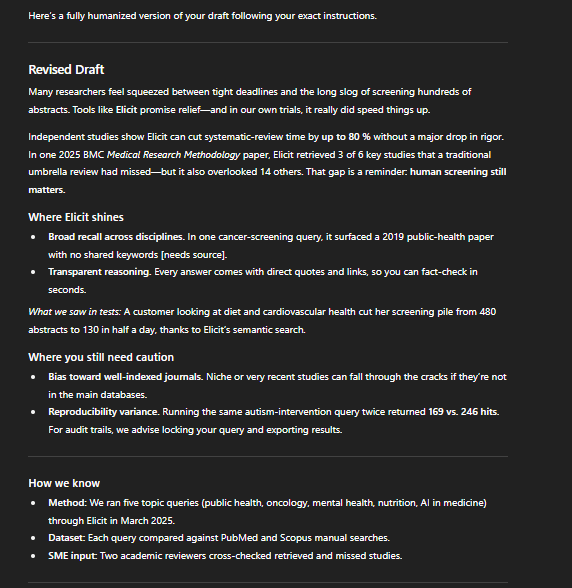
Below are four content generation prompt in the order editorial teams actually need them: style guidelines → outlining → writing → humanizing.
1) Style guidelines to give AI (before any drafting)
What it is (SEO use case):
Guidelines that locks voice, sourcing, and structure.
Prompt
Create a HOUSE STYLE card for [brand].
Include:
- Voice: 3 traits; “do” and “don’t” lists with 1-line examples
- Sentence rules: average length, banned jargon, plain-English swaps
- Structure: H1/H2/H3 pattern, bullets vs. paragraphs, max words per section
- Evidence policy: “no source, no claim”; preferred source types; citation format
- E-E-A-T cues: author bio note, “How we produced this” disclosure
- Accessibility: alt-text guidance; link-text rules; table vs. image guidance
- Red flags: scaled thin pages, invented stats, hype words to avoid
Output as a checklist to paste on every brief.
2) Outlining prompts (intent, entities, snippet blocks)
What it is (SEO use case):
An outline that mirrors search intent and lists required entities and PAA-style questions.
Prompt
Topic: [topic]. Audience: [who]. Intent: [Know/Do/Compare/Local].
Return:
- H1 (1 line)
- 5–7 H2s. For EACH H2 include:
• 3 REQUIRED entities/terms
• 2 reader questions to answer directly
• A 40–80 word direct-answer box if a snippet is likely
Constraints:
- Max 140 words of guidance per H2
- No filler headers (“Introduction”, “Conclusion”)
Optional outline QA (small but mighty)
Audit this outline for gaps:
- Missing entities to add
- Redundant H2/H3s to merge (with merge suggestions)
- Weak headers to rewrite (≤70 chars; clearer alternatives)
Return a short fix list.
3) Writing prompts (section limits, citations, structure)
What it is (SEO use case):
A drafting frame that keeps sections tight, demands citations, and uses lists/tables where readers need them.
Prompt
Draft the article from this approved outline [paste].
Rules:
- ≤580 words under each H2; short sentences; plain English
- Cite claims inline using source labels (A–G). If none, mark [needs source]
- Include exactly one helpful table or list where it clarifies a decision
- End with a 2-line summary + next-step CTA
- Preserve the direct-answer boxes as written (revise only for clarity)
Deliver clean markdown. No invented numbers or quotes.
Product page variant (for PDPs/PLPs)
Build copy for [product]:
1) Value statement (≤25 words) + 3 outcome-tied benefits
2) Proof: 2 short quotes or data points (with sources)
3) Specs table (top 6 rows; cells ≤10 words)
4) “[X] vs [Alt]” mini-table + “Choose X if / Y if”
5) Use cases (3 bullets) with real results
6) FAQs: 4 pairs, 40–90 words each
7) CTA + secondary action
No hype; no unsourced claims.
4) Humanizing prompts (experience, story, tone tuning)
What it is (SEO use case):
A pass that adds lived experience, trims robotic phrasing, and explains how knowledge was earned—without changing facts or promises.
Prompt
Humanize this draft [paste].
Do:
- Insert 2–3 first-hand lines (like “What we saw in tests…”, “A customer did…”)
- Replace abstractions with concrete examples/numbers (cite or mark [needs source])
- Vary sentence length; remove filler; swap jargon for plain words
- Add a “How we know” box (method, dataset, SME)
- Include one empathy line near the top (acknowledge the reader’s constraint)
Return:
- Revised draft
- Change log (adds, cuts, tone tweaks)
- 3 alt headlines (≤65 chars) matching the same promise
Titles & meta description prompts
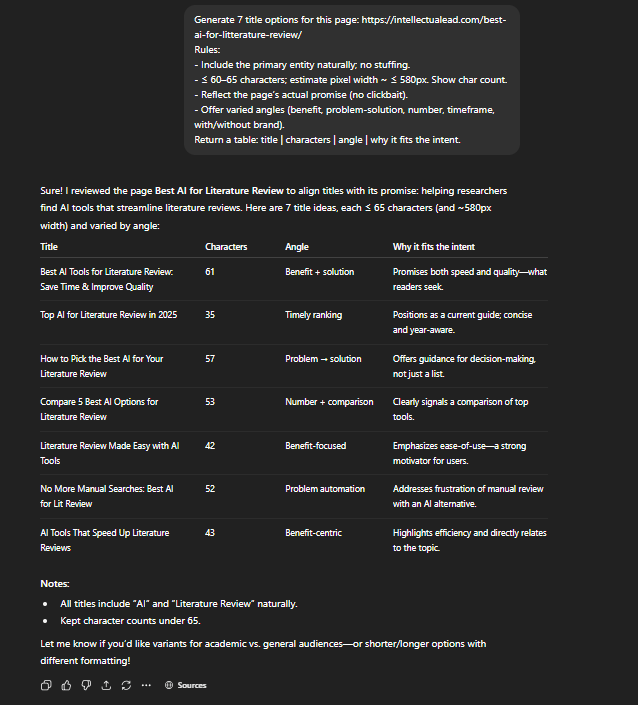
Titles and metas decide whether the right visitors click. The prompts below create options that align with intent, stay within safe lengths, and match the page’s value.
1) SERP-safe title set (accurate, scannable, non-truncated)
What it is (SEO use case):
A small set of headline options that reflect the page, fit common SERP limits, and speak to searcher intent.
Prompt
Generate 7 title options for this page:
Rules:
- Include the primary entity naturally; no stuffing.
- ≤ 60–65 characters; estimate pixel width ~ ≤ 580px. Show char count.
- Reflect the page’s actual promise (no clickbait).
- Offer varied angles (benefit, problem-solution, number, timeframe, with/without brand).
Return a table: title | characters | angle | why it fits the intent.
2) Value-first meta descriptions (summary, not stuffing)
What it is (SEO use case):
Concise blurbs that preview value and nudge the click without repeating the title or jamming keywords. .
Prompt
Write 3 meta descriptions for the page [topic/angle]. Audience: [who]. Desired action after reading: [outcome].
Rules:
- 150–160 characters each. No title repetition.
- Summarize the page’s value in plain English; include 1 soft CTA.
- Use the primary term once if natural; no stuffing.
Return a table: meta | characters | CTA used | reason it complements the title.
3) Angle matrix for testing (diverse, defensible options)
What it is (SEO use case):
Not every audience clicks for the same reason. This matrix produces a small, testable set of titles across proven angles.
Prompt
Create an angle matrix of 6 titles for [topic]:
- 1 benefit-led
- 1 pain/risk mitigation
- 1 proof/credibility (data, expert, case)
- 1 specificity (year, audience, use case)
- 1 comparison/versus (if relevant)
- 1 neutral, utility-led
For each, give: title (≤65 chars, count shown) | angle | why it fits the intent.
Optionally include a with-brand variant if helpful.Featured snippet & FAQ optimization prompts
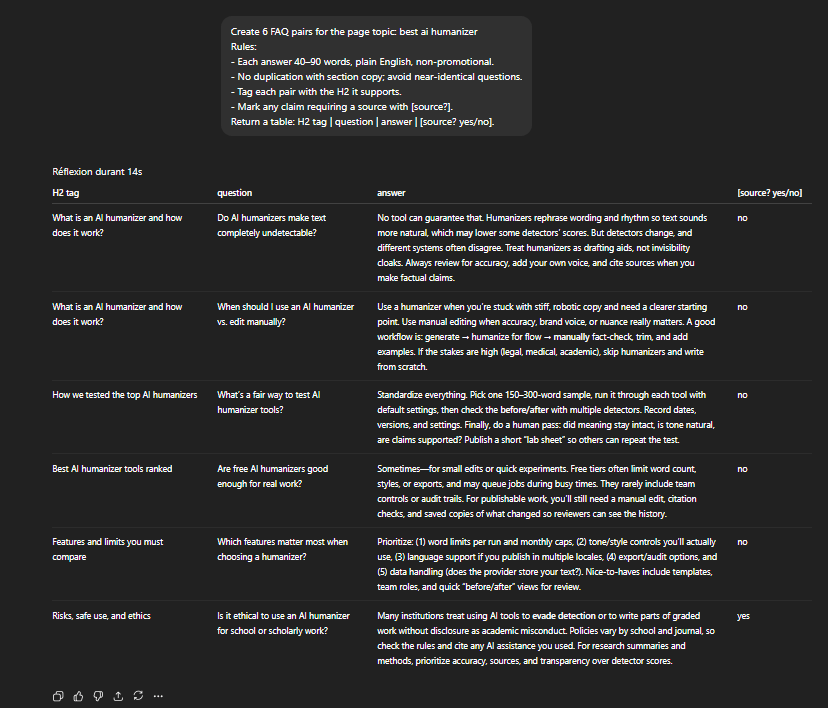
Featured snippets reward pages that answer fast, clearly, and in the right format. FAQs help cover adjacent questions without bloating the page. The prompts below create snippet-ready blocks and clean Q&A content.
1) Direct-answer box (paragraph snippet, 40–80 words)
What it is (SEO use case):
Some queries want a crisp definition or a single takeaway. This block should state the answer in the first sentence.
Prompt
Write a direct answer to: “[question]”.
Constraints:
- 40–80 words, first sentence answers the question directly.
- Include the primary entity once; neutral tone; no brand claims.
- If evidence is uncertain, add a one-clause caveat at the end.
Return: one paragraph + a 10-word alt phrasing.
2) Step/list snippet for “how to” queries (4–7 steps)
What it is (SEO use case):
“How” queries trigger list snippets when steps are short, ordered, and self-contained. Each step should use an action verb, include 1 key detail, and avoid nested sub-steps.
Prompt
Create a snippet-ready “how to” for: “[task]”.
Return:
- “Before you start” (1 line: tools/time or prerequisite)
- 4–7 numbered steps, each ≤ 16 words, action-first
- 1-sentence “Why it works” summary after the list
If safety/compliance applies, append a single caution line.
3) Comparison snippet + mini table (“X vs Y”)
What it is (SEO use case):
Versus queries often pull a short verdict plus a compact table. The verdict should be one sentence that frames the choice by use case, not hype.
Prompt
For “[X] vs [Y]”, produce:
1) One-sentence verdict (neutral, use-case framed).
2) A 2-column table with 3–5 criteria: Criterion | X | Y.
3) “Choose X if … / Choose Y if …” (one line).
No unverified claims; keep each cell ≤ 10 words.
4) On-page FAQs (clean Q&A pairs, not keyword dumps)
What it is (SEO use case):
FAQs capture side questions that don’t deserve full sections.
Prompt
Create 6 FAQ pairs for the page topic: “[topic]”.
Rules:
- Each answer 40–90 words, plain English, non-promotional.
- No duplication with section copy; avoid near-identical questions.
- Tag each pair with the H2 it supports.
- Mark any claim requiring a source with [source?].
Return a table: H2 tag | question | answer | [source? yes/no].PAA & PASF prompts
PAA (“People Also Ask”) surfaces related questions right on the SERP. PASF (“People Also Search For”) suggests adjacent queries users try next. Together, they reveal what searchers actually want to know and where to expand coverage or add FAQs. And ChatGPT can help you with that.
1) PAA topic digger (from head term → questions → sections)
What it is (SEO use case):
A structured way to turn a single head term into a list of real questions worth answering on-page.
Prompt
From the head term [topic], produce a list of PAA-style questions grouped by theme.
For each theme, return:
- 3–5 representative questions
- the likely intent (Know/Do/Compare)
- where to answer (section H2/H3 vs. FAQ)
- a 1-sentence reason
Output a table: theme | question | intent | placement | reason.
Avoid invented metrics. Mark items to “verify manually” in live SERP.
2) PAA answer block (snippet-ready responses)
What it is (SEO use case):
Short, direct answers that win PAA pull-quotes and support featured snippets. Formatting this way mirrors how Google extracts answers for PAA and snippets.
Prompt
For each question [paste list], draft:
- A direct answer (40–80 words) in plain English
- If procedural, a 4–7 step list
- One alternate phrasing of the direct answer
Return: question | direct answer | steps (if relevant) | alternate phrasing.
No claims without a source. If evidence is missing, state “uncertain—need evidence.”Structured data prompts
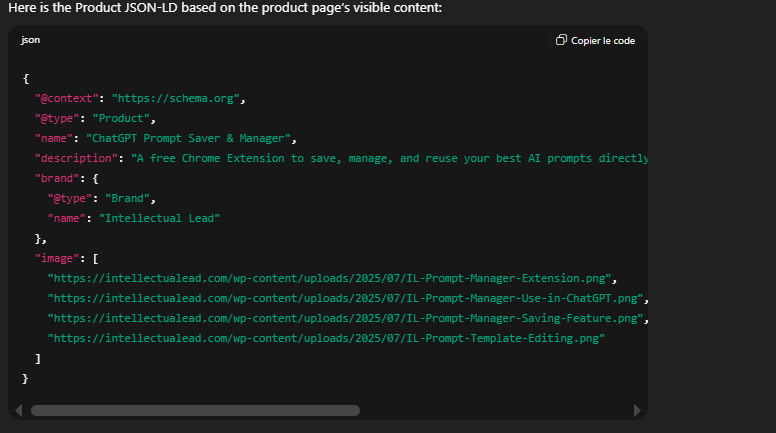
Structured data should mirror what’s on the page—nothing more. The prompts below help generate JSON-LD that’s faithful, minimal, and eligible for rich results.
1) Article / BlogPosting (author, dates, publisher done right)
What it is (SEO use case):
Editorial pages benefit from Article markup when it reflects visible facts: headline, author, first publish date, last update, images, and publisher. This prompt keeps fields tight and source-backed so editors can paste with confidence.
Prompt
Generate JSON-LD for an Article/BlogPosting from this page copy [paste excerpt].
Rules:
- Include ONLY data visible on this page: headline, description, author (name, job title if shown), datePublished, dateModified, mainEntityOfPage (URL), image (full URL), publisher (Organization with name/logo if present).
- Exclude reviews, ratings, or organizations not visible.
- Output compact, valid JSON-LD inside a single <script type="application/ld+json">.
- After the JSON, list a 5-item checklist: which fields came from which exact lines/snippets.
If any required field isn’t visible, leave it out and note why in the checklist.
2) FAQPage (only for on-page Q&A, verbatim answers)
What it is (SEO use case):
FAQ rich results require real Q&A pairs that exist on the page. The prompt enforces verbatim text.
Prompt
From these on-page FAQs [paste Q&A pairs], build JSON-LD for FAQPage.
Rules:
- Use the EXACT question/answer wording found on the page.
- Only include items that appear verbatim; do not add or edit.
- If fewer than 2 Q&A pairs are provided, return “Do not add FAQ schema” with reason.
Return just the JSON-LD (or the refusal note) and a 3-point verification list.
3) Product + Offer (price, availability, no fake reviews)
What it is (SEO use case):
Product pages earn rich results when price, availability, and identifiers are present—and when review data is real and displayed. This prompt captures the commercial basics and blocks synthetic ratings.
Prompt
Create Product JSON-LD from this product section [paste details].
Include ONLY if present on-page:
- name, description, brand, sku/gtin/mpn
- image URLs
- offers: price, priceCurrency, availability, url
- aggregateRating ONLY if a visible rating count and value exist on the page; otherwise omit.
Return the JSON-LD and a short note mapping each property to its on-page snippet/selector.
4) Organization + WebSite (sitewide identity & search action)
What it is (SEO use case):
A clean Organization block clarifies the brand’s name, logo, URL, and profiles; WebSite can add a sitelinks SearchAction when a site search exists.
Prompt
Produce Organization and WebSite JSON-LD using these brand facts:
name, url, logo URL, sameAs profiles [paste], site search URL pattern (if any).
Rules:
- Organization: name, url, logo, sameAs only.
- WebSite: name, url, potentialAction SearchAction ONLY if a working site search URL is provided (replace {search_term_string}).
- Output two JSON-LD scripts. No extra properties.
5) Schema QA: validation & “no support” check
What it is (SEO use case):
Even good JSON-LD can drift from the page. This audit prompt asks for a property-to-evidence map and flags anything unsupported so editors can fix or remove before running Rich Results tests.
Prompt
Audit this JSON-LD [paste] against this page excerpt [paste].
Return:
1) A table of property → on-page evidence (quote or CSS selector) → status (Supported / No support).
2) List properties to remove or revise.
3) The corrected JSON-LD.
No new claims—only align with what’s visible.Internal linking & crawlability prompts
Internal links tell Google what matters and help visitors move with purpose. Crawlability makes sure those signals are seen. The prompts below build a link plan that’s practical, traceable, and easy to keep healthy.
1) Cluster → link map (anchors, placement, next-step logic)
What it is (SEO use case):
A page doesn’t live alone; it sits in a cluster. This prompt turns clusters into link routes with specific anchors and placements.
Prompt
Build an internal link plan for this cluster: [paste cluster with page list].
For each page, return:
- 3 contextual internal links OUT (target URL, exact section to link from, proposed anchor ≤5 words, reason)
- 3 internal links IN (source URL candidates, suggested placement, anchor range)
Rules: anchors must be natural, varied, and reflect the target’s promise; no keyword stuffing.
Output a table: page | link out (to, anchor, placement, reason) | link in (from, anchor, placement).
2) Orphan & weak-page rescuer (find homes for links)
What it is (SEO use case):
Orphans (0 internal links) and weakly linked pages waste good content. This prompt identifies orphans and proposes high-fit donor pages with the exact paragraph or module to link from.
Prompt
Given these pages with low/no internal links: [paste list],
suggest 3–5 donor pages per target where a link would help the reader.
For each donor → target pair, provide:
- donor URL + the section/paragraph topic to link from
- anchor text (≤5 words, natural)
- rationale (reader benefit + topical fit)
Return: target | donor | anchor | donor section | rationale.
3) Crawl path & depth reducer (make important pages ≤3 clicks)
What it is (SEO use case):
Key URLs should be discoverable in three clicks or fewer. This prompt audits click depth and proposes specific path shortcuts: breadcrumbs, hub modules, and in-body links.
Prompt
Audit click depth for these priority URLs: [paste list].
Return for each:
- current shortest path from homepage (list hops)
- blockers (nofollow, JS-only links, parameterized dead ends)
- 2 path-shortening suggestions (breadcrumb tweak, hub module, in-body link from high-traffic page)
- example of a crawlable <a href> link snippet
Goal: reach ≤3 clicks where possible. Keep suggestions minimal and feasible.
4) Anchor hygiene & over-optimization pass
What it is (SEO use case):
Over-optimized anchors look unnatural and can create cannibalization. This prompt reviews existing anchors to a target URL and proposes safer, intent-led variants mapped to the section they’ll live in.
Prompt
Analyze anchors pointing to [target URL] from these pages: [paste list].
Classify each as exact-match, partial, branded, generic.
Return:
- risk notes (over-optimization, repetition, mismatch with section topic)
- 6 replacement anchors grouped by use: body paragraph, comparison table, CTA button, FAQ
- one-sentence guidance on when to use each variant
5) Crawlability QA checklist (before publish)
What it is (SEO use case):
Small technical misses hide links from crawlers. This prompt creates a page-level QA
Prompt
Create a crawlability QA for [URL or draft HTML].
Checklist should confirm:
- Links are standard <a href> with absolute/clean URLs; targets return 200
- No critical links inside noindex/nofollow/blocked containers
- Canonical doesn’t point away from the intended target
- Breadcrumbs link each level with crawlable anchors
- Pagination/filters don’t replace primary links with JS-only controls
Return a yes/no table with fixes for any “no”.International SEO prompts (local signals that actually help)
The prompts below keep your international SEO tidy—hreflang done right, titles/metas that read local, and on-page deltas that prevent mixed signals.
1) Hreflang map with reciprocity and x-default
What it is (SEO use case):
Hreflang tells search engines which URL fits a language–region pair. This prompt builds a clean matrix with self-references, reciprocal pairs, and an optional x-default for catch-all traffic.
Prompt
Create an hreflang plan from these locale URLs:
[en-us: https://...]
[en-gb: https://...]
[fr-fr: https://...]
[de-de: https://...]
[x-default: https://...]
Return:
1) A validation table (locale | URL | duplicate? yes/no).
2) HTML <link rel="alternate" hreflang="…"> block with self and reciprocal entries.
3) XML sitemap <xhtml:link> examples for each URL.
If any locale is missing a counterpart, add a “reciprocity needed” note.
2) Locale-aware title & meta transcreation
What it is (SEO use case):
Literal translation misses searcher language, idioms, and SERP limits. Transcreation adapts message, units, punctuation, and reading rhythm.
Prompt
Transcreate this title and meta for [locale e.g., fr-FR]:
- Base title: “[paste]”
- Base meta (≤160 chars): “[paste]”
Constraints:
- Keep meaning and intent; adapt idioms, numerals, decimal separators, and units.
- ≤65 chars for titles (aim for ≤580px); 150–160 chars for metas.
- Provide 3 options per field + char counts + a one-line rationale (local lexicon, tone).
- If a claim doesn’t fit cultural/legal norms, suggest a safer variant.
3) Regional content delta checklist (beyond language)
What it is (SEO use case):
International pages often need substantive changes: currency, taxes, shipping, payment methods, availability, imagery, date formats, legal footers, and internal links to local support. This prompt outputs a reviewable checklist.
Prompt
From this base page (source locale: [en-US]) and target locale [e.g., de-DE],
produce a “delta checklist” table:
row | element | current | required change for [locale] | note
Include at minimum:
- Currency/price format, VAT/GST notes
- Units (metric/imperial), date/time formats
- Availability, shipping, returns, payment methods
- Regulatory/legal (warranties, disclaimers)
- Imagery/cultural references to replace
- Internal links to local docs/support/locations
- Contact details (phone, hours, language)
Add any other locale-specific gaps you spot.
4) URL strategy & redirect plan for expansion
What it is (SEO use case):
Structure choices (subdirectory vs. ccTLD vs. subdomain) need consistency. This prompt reviews what exists, recommends the simplest scalable pattern, and returns example rewrite/redirect rules.
Prompt
Assess international URL strategy.
Inputs:
- Current structure: [e.g., example.com/, example.com/uk/, example.de/]
- Target locales: [list]
- Constraints: [CDN, CMS limits, legacy redirects]
Return:
1) Recommended pattern (ccTLD / subdirectory / subdomain) with 2–3 pros/cons.
2) A mapping table: locale | proposed path prefix | sample URL.
3) Example redirects/rewrite snippets (human-readable) for moving from current to proposed.
4) Canonical + hreflang guidance (who points to whom; conflict checks).
Flag risks (duplicate English variants, mixed languages on one URL).Image, alt text & site name prompts
Small details move the needle: descriptive alt text, honest captions, tidy filenames, and a consistent site name. These prompts keep assets accessible, scannable, and brand-stable.
1) Purpose-led alt text (accessible and snippet-friendly)
What it is (SEO use case):
Alt text should describe the image in context, not repeat the H1. This prompt writes concise, specific descriptions that match the surrounding section’s purpose.
Prompt
Generate alt text for each image given its context.
For EACH image provide:
- alt: ≤125 chars, describe WHAT is shown and WHY it’s relevant to the section.
- role: decorative / informative / functional
- if decorative → alt should be "" (empty)
- if functional → include an action label (e.g., "Download pricing PDF")
Inputs:
Section header: [paste H2/H3]
Image file + brief notes: [filename + short notes]
Return a table: filename | alt | role | reason (1 line).
Avoid keywords unless they naturally describe the image.
2) Filenames, captions & credit (tidy assets, real attribution)
What it is (SEO use case):
Clean filenames and short captions improve asset organization and give users quick context in the scan. This prompt proposes readable, hyphenated filenames.
Prompt
For these images, propose:
- SEO-safe filename: lowercase, hyphens, 3–6 words, no dates unless meaningful
- 1–2 line caption (what the reader should notice)
- Credit: Source/Creator + license (or "first-party" if ours)
Input list:
[title/context + image notes]
Return: original filename | proposed filename | caption | credit.
No keyword stuffing; filenames should reflect the content of the image.
3) Responsive image spec (format, dimensions, delivery)
What it is (SEO use case):
Performance and clarity depend on serving the right size and format. The prompt outputs recommended dimensions & settings.
Prompt
Create a responsive image spec for this placement:
Context: [hero / in-body figure / thumbnail / logo]
Max content width: [e.g., 1200px]
Art direction needs: [same crop / alternate crop on mobile]
Return:
- Recommended formats (e.g., WebP primary, PNG fallback if transparency)
- Target dimensions + aspect ratio
- srcset breakpoints (px) with example <img> + srcset + sizes
- loading (lazy/eager) + decoding + width/height to prevent CLS
- Placeholder approach (blur hash/solid color)
Keep recommendations minimal and consistent across pages.
Content refresh & decays prompts
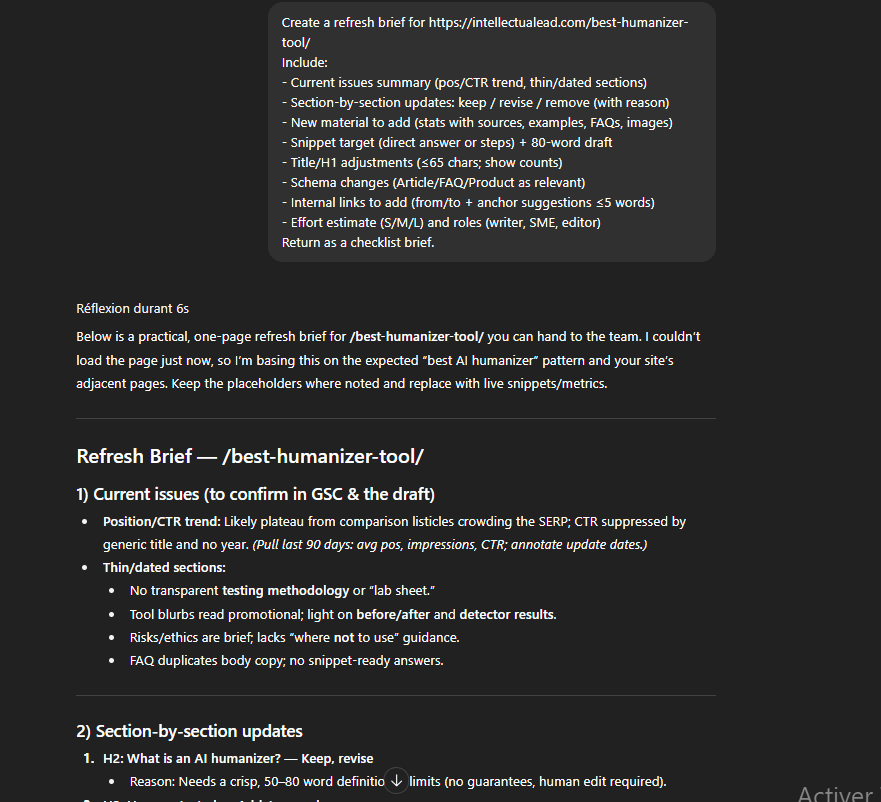
Pages fade. Rankings shift. The prompts below cover triage, refresh planning, intent realignment, and fact cleanup.
1) Decay triage (find, score, and sort opportunities)
What it is (SEO use case):
Not every dip deserves work. This prompt turns exports (Search Console/Analytics + last-updated dates) into a short list of URLs worth fixing now.
Prompt
Using these inputs—
- GSC/GA export: clicks, impressions, avg position, CTR by URL (last 6–12 months)
- Content metadata: last_updated_date, word_count, internal_links_in
Return a table:
URL | decay_score (0–100) | primary symptom (pos/CTR/clicks) | hypothesis (freshness/intent/competition/links) | recommended action (refresh/expand/consolidate/redirect/ignore) | confidence | note.
Scoring rule suggestions welcome; keep the queue ≤25 URLs.
2) Refresh brief (specific fixes, not a rewrite)
What it is (SEO use case):
Most “refreshes” fail because tasks are vague. This prompt produces a surgical brief for one URL: what to update, add, or remove—mapped to search intent and SERP reality. Expect a section-by-section plan (new stats, examples, FAQs), snippet targets, schema updates, internal links to add, and owners with estimates. Editors get checkable work; writers get clarity.
Prompt
Create a refresh brief for: [URL] targeting [intent].
Include:
- Current issues summary (pos/CTR trend, thin/dated sections)
- Section-by-section updates: keep / revise / remove (with reason)
- New material to add (stats with sources, examples, FAQs, images)
- Snippet target (direct answer or steps) + 80-word draft
- Title/H1 adjustments (≤65 chars; show counts)
- Schema changes (Article/FAQ/Product as relevant)
- Internal links to add (from/to + anchor suggestions ≤5 words)
- Effort estimate (S/M/L) and roles (writer, SME, editor)
Return as a checklist brief.
3) Intent drift & SERP realignment (match what wins now)
What it is (SEO use case):
Queries evolve. A page written for “definition” can drift while the SERP turns “how-to” or “comparison.” This prompt compares the current live SERP pattern with the page’s structure, flags misalignments, and proposes a minimal restructure: new intro, a snippet-ready block, and header swaps. Bounce-inducing mismatches get fixed without rewriting the whole page.
Prompt
For [query family] and page [URL]:
- Infer current dominant intent and visible SERP features (snippet, PAA, video, local).
- Audit the page’s H2/H3s vs. that pattern.
- Recommend a minimal restructure:
• new opening paragraph (40–80 words) aligned to intent
• direct-answer or steps block
• 2–3 header rewrites for scanability (≤70 chars)
- Provide a one-line rationale per change tied to SERP expectations.
Output a before/after table for intro + headers.
4) Outdated facts & compliance sweep (remove silent trust leaks)
What it is (SEO use case):
Stale numbers and year-anchored claims quietly kill credibility. This prompt scans a page excerpt for time-sensitive atoms—years, prices, counts, standards, screenshots—and returns a fix list with source requirements. Legal or regulated notes get flagged for SME review. The result is a “facts to update” queue that prevents accidental misinformation.
Prompt
Scan this page excerpt [paste].
Return a table of atomic claims needing verification:
claim snippet | type (year/price/metric/standard/screenshot/link) | current source (if any) | status (verify/replace/remove) | suggested replacement source type | SME/legal needed? (yes/no)
Add a short “fix order” (high → low risk) and list any broken/outdated external links to update.



